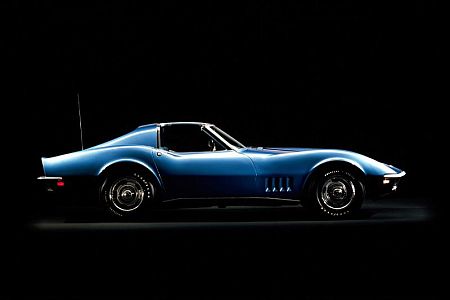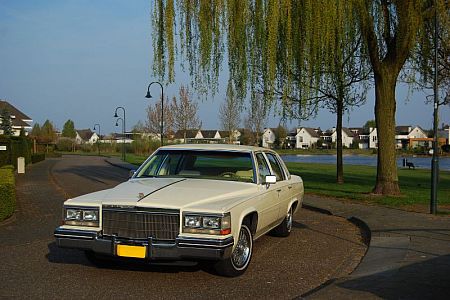Chevrolet Corvette C3
Some feel that 'American' and 'sports car' do not fit in the same sentence, others consider the Chevrolet Corvette an icon in automotive history. And then there is a group of people who find the dramatic styling and raw violence of generation C3 (1968-1982) immensely appealing, but do not dare to come out openly for it. One day, however, these enthusiasts will no longer be able to resist, and that is perfectly understandable.

Inspiration and introduction of the Corvette C3
The design of the Chevrolet Corvette C3 was defined by the 1965 Mako Shark II concept car. Striking rising wings, a wavy waistline and a crease in the sides gave the car a powerful look that perfectly suited the various V8 engines in this lightweight sports coupé.
The car made its debut in 1968 and received its first facelift in 1973, introducing a plastic front bumper. The interior was somewhat limited due to its shape, especially for those on the continent where the car was born. To compensate, however, Chevrolet offered two removable roof panels for the closed model, while the Convertible was of course a unique experience in itself.

In stark contrast to General Motors' large sedans at the time, the Corvette had a sleeker appearance. This definitely did not deter the American buying public from having such a sports car as a second or third car in the garage.
Small block and big block
The Chevrolet Corvette's engines can be divided into small block and big block, initially with 5.4 and 7.0 litres respectively. This was soon followed by the 5.7 and 7.4 litre engines, with power outputs reaching incredible 504 hp. This remained so until the heavy-hitters were affected by international oil and US emissions regulations.

In 1974, the powerful 454 (named after the number of cubic inches) disappeared, leaving the 350 engine.
Shock-absorbing bumpers
Meanwhile, a beautifully integrated, shock-absorbing bumper had been a signature addition to the Corvette's front end for a year. The following season, the rear was similarly tackled, giving the car a much more modern look. Unfortunately, the Convertible could only benefit from this for a short time, as it experienced its last year of production in 1975.
Chevrolet Corvette C3 Stingray
From 1969 the C3 was officially nicknamed Stingray (written as one word, unlike the C2), but from mid-1976 the term was no longer used.
A year later, the manufacturer ventured to completely redesign the rear of the Corvette, with a large panoramic window that unfortunately could not be opened. This left luggage compartment accessibility problematic, which was not solved until 1982 with the Collector Edition: this glass roof could indeed be opened.

Silver Anniversary
Americans love limited editions, so Chevrolet took advantage of the 1978 Silver Anniversary of the Corvette. They introduced both the Silver Anniversary and a replica of the Indy 500 Pace Car. The spoiler system used in the latter was also later offered separately as an option. By the early 1980s, every Corvette received a lip at the rear and under the front bumper, with another design intended to improve aerodynamics.
As a final improvement, Chevrolet introduced an injection engine and a four-speed automatic transmission in late 1981. Meanwhile, the new generation C4 was ready to debut.
What should you look out for when buying a Corvette C3?
As mentioned earlier, the Corvette C3 is highly sought after. Therefore, you won't find it in the bargain corner anytime soon, and if you do come across one at that level, be very wary. The engineering is not known to be complex, but a neglected car will certainly cause high costs. If it looks too good to be true... Don't expect a godsend, as every seller knows that a Corvette from this period is a favourite among enthusiasts.
Both in the US and here, cars are regularly offered that are not much better than pulp. It is immediately obvious that it has a lot of work on it and this is reflected in the price. Realise then that repairing the car is likely to be much more expensive than buying a healthy one, even if you are willing to work on it yourself. Repairing any cracked polyester, the material from which the bodywork is made, requires specialist craftsmanship, by the way.
Maintenance and repairs
A well-maintained Chevrolet Corvette rarely causes unpleasant surprises, as the car is known for its simplicity. So if you can get hold of a healthy one, you will save yourself a lot of hassle and if you do regular maintenance, you will enjoy it for a long time. This is where the car stands out from many other sports cars. Keep in mind, though, that the car's American origins are reflected in its character. You won't find the razor-sharp and nervous handling of, say, a Ferrari here, although the Corvette certainly doesn't shy away from a dynamic ride.

Most of the cars are equipped with an automatic transmission, by the way. In many ways, conviviality is key, and that is precisely what makes this sports car so versatile, suitable for daily use, with the reassurance that with regular maintenance, the technology will rarely let you down and you can keep a close eye on the overall cost. Tell me, what exotic car can match that?




